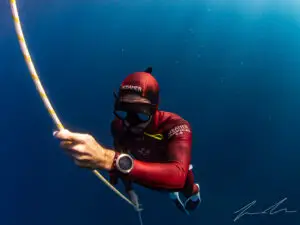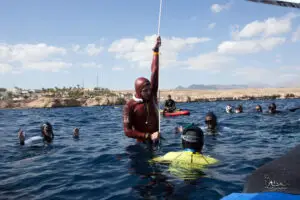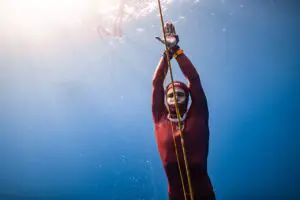The Canadian Pacific Northwest is a stunning place for scuba diving, freediving or snorkeling. It offers some of the cleanest waters in the world, fantastic underwater landscapes and unbelievable marine wildlife.
The only issue for many people that wish to take part in these activities around Vancouver, the Gulf Islands or Victoria, is that for most of the year the water is quite cold.In the summertime, the Howe Sound can have surface water temperatures that range between 14 to 20 degrees Celsius. However, it’s always cold below the thermocline.
The advantage of summer diving is of course the radiant heat of the sun and the surface water temperature (see Jaap’s blah-blah about wetsuit heat loss). So if this sounds awesome why even bother diving in the cold, wet winters of the west coast? Well, the answer is similar as to why a diehard surfer from Tofino, British Columbia gets in the water in January: the conditions are epic in the winter.
First off, there are less algae blooms during this period, which means that rather than diving in pea soup, you can get fabulous visibility, sometimes even 30+ meters.
Second, your Mammalian Dive Reflex kicks in faster. If you time your dive correctly you can have some of your best dives in cold water. Timing correctly means that you are warmed up enough but you haven’t lost sensation in your toes yet
Finally, the wildlife during these winter months is spectacular. For example, in February you can go diving with stellar sea lion pups. You are also more likely to see seals checking you out underwater.So here are a five tips I’ve put together from both personal experience and passed on by others that I’ve adopted to make those frigid dives far more enjoyable:
Before the cold water dive
- Plan your dives ahead of time and check weather conditions. Diving at high tide maximizes your chance of good visibility and ease of access/entry in the water. Check both tidal and current charts to dive at slack for ease and safety too. Hopefully these coincide with midday, where you have the most sun radiance during winter time. Avoid days with strong winds, since you’ll get cold before you set a foot in the water and it tends to generate surface waves which makes it trickier to relax.
- Wool and more wool! stay warm and dry before the dive, in fact try to overheat yourself a bit by wearing a wool tuque, wool socks and many layers that keep you really comfortable. When you put on your wetsuit, wipe off any excess lube that’s exposed on surfaces like your hands, feet and face.
- Bring a cooler full of hot water for before and after the dive. You can put your bottle of lube inside it, as well as any warm food (soup is ideal) in a water tight container for your post-winter dive hunger.
- Drink lots of hot fluids, such as hot tea before the dive. Yes, this will cause you to pee in your wetsuit but it’s well worth it. The best way to warm up is from the inside. Try making your own turmeric and ginger tea blend: cut both turmeric and ginger roots very finely, let them boil on low for a about 30 minutes and then dilute it if it’s too concentrated. Add some honey if it’s too strong. Ginger has the apparent amazing property of being a thermogenic substance. That means, it warms you up. Of course if it increases metabolism, your performance might be reduced. Perhaps we can overlook this for winter dives, where staying warm is a priority. Also, try to dive with shorter recoveries (although obey the 2:1 recovery principle), this will keep you moving more, train your tolerance to CO2 and extend your dive time!

During the cold water dive
- Use as much neoprene as you comfortably can. If you have a 5mm wetsuit consider getting a 7mm top. 5mm gloves and socks are also great when the water temperature drops below 10C. If the foot pockets of your fins are too small to fit thicker socks and they are closed, try to buy the largest size available, cut the ends of the toes off and put it over the foot pockets, on the outside. I do this with my monofin since I cant wear socks and it definitely delays the eventual numbness. Don’t forget to adjust your buoyancy like you learned in your freediving course.
After the cold water dive
- The best part. Remember that hot water you brought? It’s shower-time. That water is great for rinsing out any urine in your wetsuit. Remember, any freediver that tells you they don’t pee in their wetsuit are either grossly dehydrated or just lying to you. Be careful of using the hot water on your fiberglass fins and other gear because the sudden temperature change may cause it to fracture
Let us know your tricks to staying warm in cold water in the comments!





High Fives for the cooler full of hot water trick. I thought is was pretty wierd the first time I saw a hot water cooler coming aboard, but there are no words for how good it feels pouring into your wetsuit after a dive in 8c water!
Couple of things I remember Eric F posting about, hot packs and supplements that increase heat production, mostly by affecting liver function. I don’t remember the details, other than both ideas were tricky.
Supplements that affect liver function do sound tricky… I’ve never been able to find hot pads that are fully waterproof and reusable but have heard of divers using those. They would put hot pads in the arm pits, on the back of the neck, and in the groin so that their core stays warm in cold water.
Very useful tips. As the coldest temp in Taiwan is 16c but with strong wind.
Pingback: Ice & Ice: Climbing and Freediving on Frozen Giants - Freedive Wire
Pingback: Freediving in BC - Freedive Wire